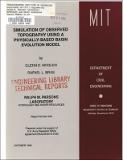| dc.contributor.author | Moglen, Glenn E. | en_US |
| dc.contributor.author | Bras, Rafael L. | en_US |
| dc.date.accessioned | 2022-06-13T13:15:06Z | |
| dc.date.available | 2022-06-13T13:15:06Z | |
| dc.date.issued | 1994-10 | |
| dc.identifier | 340 | |
| dc.identifier.uri | https://hdl.handle.net/1721.1/143083 | |
| dc.description | Prepared under the support of the U.S. Army Research Office under agreement DAAL03-92-G-0182 | en_US |
| dc.description.abstract | This work presents a model for basin evolution and a procedure for estimating the parameters of this model to reproduce a given topography. The model is calibrated based on three measures: the slope-area relationship, the cumulative area distribution, and the hypsometric curve. We find that these measures quantify fundamentally different characteristics of the drainage basin. We show that spatial variability and structure are inherently necessary to sufficiently reproduce observed statistics of a basin. The presence of uncorrelated spatial variability introduces scatter to the slope-area relationship which is consistent to the scatter observed for an observed system. Uncorrelated spatial variability also influences the cumulative area distribution by causing the drainage aggregation pattern to encompass a greater spread of cumulative drainage areas around the representative hillslope scale. In contrast, a system with no spatial variability exhibits an almost single-valued distribution for the representative hillslope scale. We illustrate how the channel selectively chooses pixels of greater susceptibility to erosion in which to grow. Based on a knowledge of the underlying distribution of spatial heterogeneities, we show that channel extension is limited to effectively three potential growth sites at any location. These results were confirmed for two different distributions: normal and uniform. This channel selectivity has the consequence of reducing the mean channel slope by an analytically determined amount based on the fluvial sediment transport parameters and the distribution of heterogeneities. We analyze the effect of spatially correlated soil heterogeneities on simulated basins. Such correlations cause a shift in the slope-area relationship power-law exponent, 6. Correlated heterogeneities also have a profound influence on the hypsometric curve. We show how correlated erosivity in the horizontal direction leads to smaller mean basin elevations compared to the control or prototypical case. Meanwhile, stratification in heterogeneities may lead to larger or smaller mean basin elevations depending on the stratification pattern. The process for calibrating the basin evolution model to statistically reproduce a given topography is presented. The process entails making initial estimates of model parameters from the observed slope-area relationship and using a numerical optimization package to determine the remaining parameter values. The numerical optimization process employs an off-line version of the evolution model which predicts the cumulative area distribution that would result from a given set of parameter values. The optimization selects the model parameters that will best reproduce the observed cumulative area distribution. The resulting simulation may be subsequently improved to reflect stratification or any other peculiarities that are present in the observed system. Finally, we illustrate how the hydrologic response of a simulated basin is a function of the basin evolution model parameters that created it. Most notably, we show that the distribution of saturated areas is significantly affected by the presence of spatial heterogeneities in erosivity. Results indicate that as heterogeneities increase within a basin, there is a greater spread in saturation indices. Thus, as the degree of heterogeneity in erosivity increases within a basin, the predicted runoff response from the basin becomes decreasingly sensitive to errors in estimation of the degree of saturation. | en_US |
| dc.publisher | Cambridge, Mass. : Ralph M. Parsons Laboratory, Hydrology and Water Resources, Dept. of Civil Engineering, School of Engineering, Massachusetts Institute of Technology | |
| dc.relation.ispartofseries | R (Massachusetts Institute of Technology. Department of Civil Engineering) ; 94-07. | |
| dc.relation.ispartofseries | Report (Ralph M. Parsons Laboratory for Water Resources and Hydrodynamics) ; 340. | |
| dc.relation.uri | https://hdl.handle.net/1721.1/11747 | |
| dc.title | Simulation of Observed Topography Using a Physically-based Basin Evolution Model | en_US |
| dc.identifier.oclc | 31887595 | |
| dc.identifier.aleph | 947773 | |
